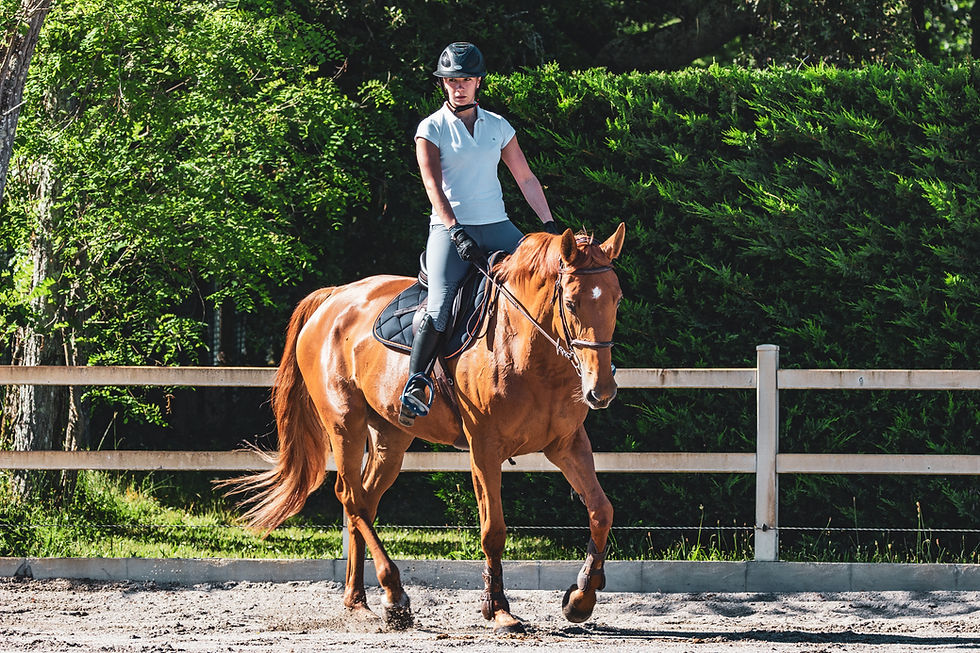To Scrape or Not To Scrape: What Research Says About How To Cool Down Your Horse
- AHLERI Equine Products

- Jul 1
- 3 min read
Scraping vs. not scraping is a hot topic right now! There is a lot of debate about whether or not you should leave water on your horse after hosing them off, and how best to cool them down after exercise. In this article, we'll discuss a 2020 comprehensive study that delved right into this topic! Read the study for yourself by clicking here.

🐎 1. What Was the Study About?
Researchers in Japan set out to find the best method to cool down Thoroughbred horses after intense exercise in hot, humid conditions. Their aim: help horses return to a normal internal temperature more quickly to protect their health and well-being.
They compared five cooling methods:
Just walking the horse (no cooling aids)
Walking with fans
Walking and intermittently spraying cold water (~50 °F), with scraping off water after each spray
Same as #3 but without scraping — leave the water on
Stationary horse under continuous cool tap water (~80 °F), like a steady shower
Two key measures were used:
Time to reduce core temperature to below 102 °F
Temperature 30 minutes after ending exercise
🔥 2. Why Reducing Core Temperature Matters

Horses working hard in hot, humid weather can reach body temps around 108 °F — dangerously high and a risk for heatstroke, organ damage, or exhaustion. Rapid cooling helps prevent complications like dehydration (from water loss due to sweating) and muscle damage.
❄️ 3. Should You Scrape Water Off Your Horse? The Results Say...
Here’s how quickly each method worked:
Walking only: ~ 25 minutes to cool down
Walking + fans: ~ 15 minutes
Walking + intermittent cold water + scraping: ~ 12 minutes
Walking + intermittent cold water no scraping: ~ 10 minutes
Stationary + continuous cool water: ~ 2 minutes
The standout method was the continuous cool water shower, cooling horses about 5× faster than intermittent cold water.
Even using tepid tap water (~80 °F) continuously outperformed cold-water sprays with scraping.
💧 4. Why Continuous Water Works So Well

Dr. David Marlin, a thermoregulation expert, has weighed in: scraping off water might actually slow cooling. He identified four key factors influencing cooling:
Area covered – more skin contact cools faster
Temperature difference – between horse’s skin and water
Volume of water – more water means more heat removal
Rate of application – constant flow beats intermittent sprays
A steady shower keeps water and air moving, maximizing heat loss via evaporation and convection. Scraping interrupts this.
🩺 5. But Could Cooling Too Quickly Harm the Horse?
You might worry that applying very cold water could cause muscle issues or "tying up." A 1995 equine study tested whole-body hypercooling with ice-cold water (48 °F) vs. tepid water (90 °F). They found that:
Hyper-cooling with cold water safely reduced body temperature
There was no increase in muscle problems or myopathy ("tying up")
That gives confidence: using cooler water continuously is effective and safe.
✅ 6. Practical Takeaways for Horse Care
If you’re working horses on hot, humid days, here’s a step-by-step recommendation:
End work once core temp hits ~ 108 °F
Move the horse to a shady, open area
Apply a continuous shower of tap-temperature water (~70–80 °F) across the whole body
Avoid scraping — let water flow and evaporate
Monitor until temperature drops below 102 °F, which should take ~ 2 minutes
Check again 30 minutes later to ensure safe recovery
Overall, a light, steady shower is faster, safer, and easier than intermittent cold-water sprays plus scraping.
🧠 7. Broader Lessons from the Study

Evidence-based: Tools beat tradition. The study challenged widely used methods and showed continuous water is best.
Mechanics matter. Heat transfer principles — contact, temperature, rate — are crucial.
Let the science guide practice. Very cold water can be safe and more efficient.
Context is key. Results came from tests in hot, humid conditions with high-intensity exercise. For cooler settings, adjustments may be needed.
📌 8. Final Summary
So. Should you scrape water off your horse? This research compared five common cooling strategies and found:
Best method: continuous shower with tepid water (about 80 °F) — cooled horses in ~2 minutes
Less effective: intermittent cold-water sprays, scraping, fans, or just walking — taking 10–25 minutes
Safe: no muscle issues found with cold water
So if you want your horse to bounce back fast after hot-weather exercise — start a gentle continuous shower and keep it flowing. It’s simple science with effective results.
_edited.png)
_edited.png)
.png)







Comments